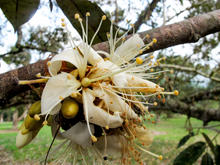Durio graveolens
A tall tree with buttresses, similar in general habit to the common duriun tree. This species grows wild in Borneo, the Malay Peninsular, Sumatra (Soegeng-Reksodihardjo, 1962) and thailand (Pengklai, 2005). It is also often found in secondary forest. The pulp in much preferred by the natives for relish and usually made into "sajur" soup. The harvesting fruits, whole tree is often cut down when fruit nearly ripe because the tree is too tall for climbing and fruits do not fall when ripe. Many animals are attracted to the tree for eating red arils(Soegeng-Reksodihardjo, 1962).
high chromosome numbers with 2n=72 common (Brown, 1997)
Vegetative parts
Tree with buttresses root, up to 45 m tall. Bark finely cracked (or rather smooth), rusty or light brown, 1‒2 thick. Living bark rusty brown, inside paler. Sapwood white, yellowish or pinkish, merging into the darker, rather tough heartwood. Branchlets more or less angular, apex thick, some what flattened, densely covered by coppery, dark brown scales.
Leaves alternate, coriaceous, elliptical to oblong, 10‒26 by 4‒10 cm; base rounded or slightly contracted into petiole; apex abrubtly, shortly acuminate, acumen 6 mm, pointed; upper surface very glossy glabrous (that of the flush with very sparse stellate hairs), under the lens inely densely reticulate; midrib channelled; lower silvery of gold-colored (fresh), densely covered with coppery brown scales; lateral nerves 10‒13 pairs, rather straight. (Kostermans, 1958)
Leaf upper surface with very sprace stellate hair of D. graveolens (using peeling method). Scale bar = 100 µm
Leaf upper epidermal cell of D. graveolens (using peeling method). Scale bar = 50 µm
Leaf lower surface of D. graveolens (using peeling method). Scale bar = 100 µm
Reproductive parts


Flowers in cymous inflorescences on old branchlets or on older branches, of 2,3 or more flowers (rarely flower solitary); peduncles and peidels thick, angular, densely covers by dark brown scales, pedicel 1 cm long.
Epicalyx which covers the elongate, ovoid bud, splits into two lobes, outside with a dense layer of pale brown scales, inside with a dense layer of minute
Calyx thin, pale greenish, 3‒5 lobed, tube 1 cm long, up to 1.5 cm wide
Corolla 5 broadly spathulate-roundate petals, white, erect, outside densely covered with minute stellate hairs; claws conspicuous, 1 by 1.5 cm, broader toward apex
Stamens and staminodes in 2 phalanges, white, glabrous, erect, 4 cm long, the lower third part connate (some filaments completely free); anthers reniform, about 2 on each filament, brown, dehiscent with slits
Ovary ovoid, 5 by 4 mm, whitish densely convered with large golden brown scales, greenish white style shich is a little longer than filaments, stigma pale yellow
Fruit orange-yellow, globose or somewhat ellipsoid, about 10‒15 cm in diameter, with sharp pyramidal; valves pointed at both ends woody when dry; seeds sllipsoid, 4 by 2 cm , completely encolsed by an edible, flexhy, dark red arit; tate of aril sweetish, smell none (Kostermans, 1958)
Borneo, Malay eninsular and Sumatra (Soegeng-Reksodihardjo, 1962)
Thailand (Pengklai, 2005)
Singapore (Wyatt-Smith, 1953)
